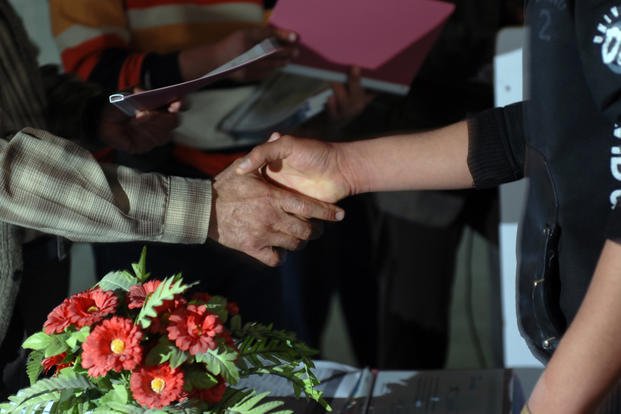Communicating confidence and reliability is essential to the success of any business. And since administrative assistants are often on the front lines of a company's public image, knowing how to make a good first impression is one of the unspoken but fundamental parts of their jobs.
Whether you're interacting with a customer, your boss or a colleague in another company, a confident, well-executed handshake is one of the best business skills you can cultivate to ensure that each new encounter gets off on the right foot -- and that you are representing yourself and your company positively.
Anatomy of a Perfect Handshake
A handshake is "an opportunity to establish rapport and positive chemistry," suggested Dana May Casperson in "Power Etiquette: What You Don't Know Can Kill Your Career." "An immediate bond develops from the touch of a hand that sets the tone for conversation and future business association."
While a handshake might seem a fairly simple and straightforward gesture, there are nuances involved with this highly psychological social ritual. These expert tips will help you ensure that your handshake is communicating what you want it to:
Get the Timing Right.
Shake hands whenever you are introduced to someone, whenever you introduce yourself to someone, and whenever you say goodbye, Casperson said.
Speak Up.
Say something when you shake hands, Casperson suggested. You can acknowledge the person's name and say, "It's very nice to meet you, Mr. Jones," or, "Good to see you again."
Get a Grip.
Your grip speaks volumes, Peter and Peggy Post said in "The Etiquette Advantage in Business: Personal Skills for Professional Success." A limp one suggests hesitance or mousiness, while a bone cruncher can seem overly enthusiastic or domineering. A medium-firm grip conveys confidence and authority.
Dry Your Palms.
Nobody likes clammy hands, said Jennifer Star, co-president of The Jennifer Group, a New York City-based recruiting firm specializing in administrative support staff. Sweaty palms communicate nervousness, which can subconsciously make people feel like you've got something to hide. Star suggests carrying Kleenex or liquid baby powder to rub on your palms before shaking hands.
Shake Palm to Palm.
Make sure you shake palm to palm and keep your hand perpendicular to the ground. An upturned palm may subconsciously signal submissiveness -- a downward palm, dominance, said the Posts. And while grasping the top of the person's hand with your other hand while shaking can often be a signal of warmth and affection, the Posts caution that this forward of a greeting might seem presumptuous or insincere when used in a first meeting.
Mind Your Audience.
Be observant and follow the cues of those around you, Casperson said. Respond with pressure that meets the pressure you receive. Don't try to overpower the other person if their grasp is more timid.
And be aware that different social boundaries prevail in different cultures. In North America and Europe, a firm handshake is an appropriate form of greeting, the Posts said. In Asia and the Middle East, where handshaking is still relatively new, the grip is gentler; a too hearty grip could be interpreted as aggressive.
Know When to Let Go.
The ideal handshake lasts approximately three seconds. The hands can be gently pumped once or twice, and then it's time to pull back your hand, even if you are still conversing.
Want to Know More About the Military?
Be sure to get the latest news about the U.S. military, as well as critical info about how to join and all the benefits of service. Subscribe to Military.com and receive customized updates delivered straight to your inbox.











